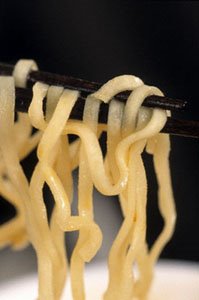Noodles (Miantiao)

Noodles are a form of staple food very popular among the Chinese. They can be made either by hand or by machine and, by the way they are made, are divided into "cut noodles" or "dried noodles." Made in whatever way, they may be of different widths, varying from ribbons to threads. As a prepared dish, they can be served warm or cold, dressed with chilli oil or not, eaten with fried bean sauce, port or chicken sauce, duck chops, soup of any concoction and what not.
There is also a variety of "instant noodles", which are precooked, dried and commercially packed. Before eating, all one has to do is to soak them in hot, boiled water for a few minutes. They are very handy for a quick lunch in the office or on a journey.
As noodles are always in the form of long strings, they are symbolic of longevity and are therefore indispensable at Chinese birthday parties.
Two types of noodles stand out among the rest and require professional skill. The "hand-pulled noodles" are probably unique to China and can be made only by a trained cook. He prepares the paste by stretching it in his hands and, holding it stretched and shaking it gently up and down four or five times, lets down the middle of the long paste and swings it in such a way that it twists around itself. He repeats the stretching, shaking and twisting many times until he feels the paste is firm enough. Then, on a work board he starts pulling the paste with his arms stretched. He folds the thick string of paste into two, pulling again. This he repeats many times over and the strings of paste become longer, more numerous, thinner and thinner, turning finally into very fine noodles. The whole process of making "hand-pulled noodles" is done with such magical dexterity that to watch an experienced cook at it is like enjoying a juggler's show.
Another speciality that one cannot make at is longxu mian (dragon beard noodles). Commercially they are available fried, so they are golden in colour, crisp to the bite and with a distinctive flavour. "Dragon beards" are also hand-pulled but are made extraordinarily fine. It has been calculated that a piece a paste prepared with 1.5 kilograms of wheat flour can make 144,000 hair-thin noodles, each 0.17 metres long, which means a total length of 2 kilometres.
At the beginning "dragon beards" were simply called "beards," but since they caught the fancy of an emperor and as the dragon was the symbol of all emperors, they have come to be known as "dragon beards."




0 Comments:
Post a Comment
<< Home